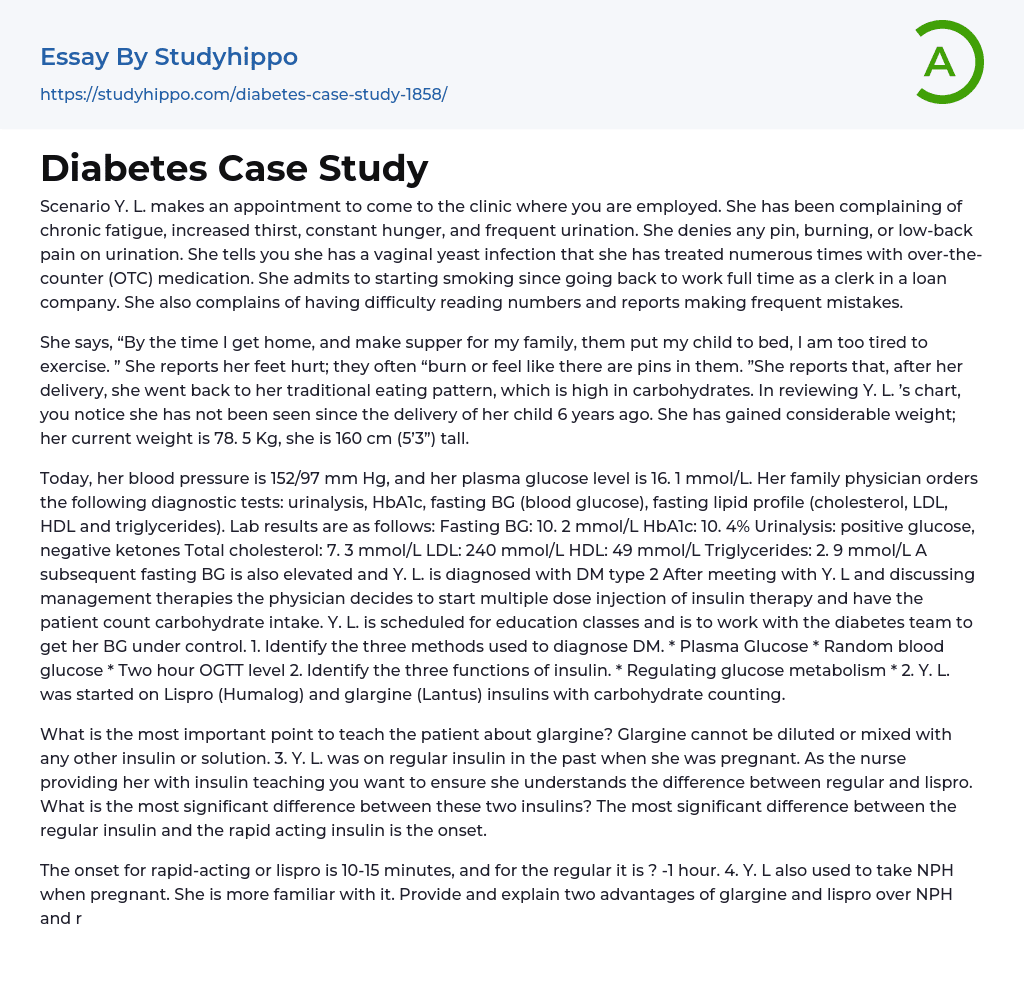Scenario Y. L. makes an appointment to come to the clinic where you are employed. She has been complaining of chronic fatigue, increased thirst, constant hunger, and frequent urination. She denies any pin, burning, or low-back pain on urination. She tells you she has a vaginal yeast infection that she has treated numerous times with over-the-counter (OTC) medication. She admits to starting smoking since going back to work full time as a clerk in a loan company. She also complains of having difficulty reading numbers and reports making frequent mistakes.
She says, “By the time I get home, and make supper for my family, them put my child to bed, I am too tired to exercise. ” She reports her feet hurt; they often “burn or feel like there are pins in them. ”She reports that, after her delivery, she w
...ent back to her traditional eating pattern, which is high in carbohydrates. In reviewing Y. L. ’s chart, you notice she has not been seen since the delivery of her child 6 years ago. She has gained considerable weight; her current weight is 78. 5 Kg, she is 160 cm (5’3”) tall.
Today, her blood pressure is 152/97 mm Hg, and her plasma glucose level is 16. 1 mmol/L. Her family physician orders the following diagnostic tests: urinalysis, HbA1c, fasting BG (blood glucose), fasting lipid profile (cholesterol, LDL, HDL and triglycerides). Lab results are as follows: Fasting BG: 10. 2 mmol/L HbA1c: 10. 4% Urinalysis: positive glucose, negative ketones Total cholesterol: 7. 3 mmol/L LDL: 240 mmol/L HDL: 49 mmol/L Triglycerides: 2. 9 mmol/L A subsequent fasting BG is also elevated and Y. L. is diagnosed wit
DM type 2 After meeting with Y. L and discussing management therapies the physician decides to start multiple dose injection of insulin therapy and have the patient count carbohydrate intake. Y. L. is scheduled for education classes and is to work with the diabetes team to get her BG under control. 1. Identify the three methods used to diagnose DM. * Plasma Glucose * Random blood glucose * Two hour OGTT level 2. Identify the three functions of insulin. * Regulating glucose metabolism * 2. Y. L. was started on Lispro (Humalog) and glargine (Lantus) insulins with carbohydrate counting.
What is the most important point to teach the patient about glargine? Glargine cannot be diluted or mixed with any other insulin or solution. 3. Y. L. was on regular insulin in the past when she was pregnant. As the nurse providing her with insulin teaching you want to ensure she understands the difference between regular and lispro. What is the most significant difference between these two insulins? The most significant difference between the regular insulin and the rapid acting insulin is the onset.
The onset for rapid-acting or lispro is 10-15 minutes, and for the regular it is ? -1 hour. 4. Y. L also used to take NPH when pregnant. She is more familiar with it. Provide and explain two advantages of glargine and lispro over NPH and regular. 5. Y. L’s culture prefers foods high in carbohydrates. What is carbohydrate counting, and why would this method work well for Y. L.? Carbohydrate counting requires the person to count the carbohydrates in the foods they eat and to set a limit to how much he/she can
eat in a day to keep their blood glucose in range.
This helps control blood glucose levels because carbohydrates increase glucose levels more than any other food. 7. Which of the symptoms that Y. L. reported today led you to believe she has some form of neuropathy? When Y. L. stated that her feet hurt and they often burn or feel like there are pins in them, it led me to believe that she has some form of neuropathy. 8. Describe three changes that Y. L. can make to reduce the risk or slow the progression of: a) macrovascular and b) microvascular disease (describe 3 changes for each) a)Healthy eating and exercise are first line intervention.
If lifestyle changes are insufficient, lipid lowering therapy such as statins, fibrates, or both may be added to optimize lipid levels, and thus reducing the risk of a vascular event. b)Diabetic Retinopathy: Patient should get frequent and regular eye exams and to not wait until signs and symptoms appear. Neuropathy: Controlling blood glucose within normal range < 7 mmol/L, good foot and skin care. Nephropathy: Good glucose control, diet and activity levels. In all cases provide patient with resources such as dietician, exercise program, smoking cessation, foot care, blood pressure clinics.
- Type 2 Diabetes essays
- Cloning essays
- Medical Ethics essays
- Patient essays
- Therapy essays
- drugs essays
- Cannabis essays
- Aspirin essays
- Cardiology essays
- Hemoglobin essays
- Pharmacology essays
- Surgery essays
- alternative medicine essays
- Plastic Surgery essays
- Organ Donation essays
- Vaccines essays
- Medical essays
- Dentist essays
- Psychological Trauma essays
- Physical therapy essays
- Cold essays
- Cocaine essays
- Why Marijuana Should Be Legalized essays
- Drug Abuse essays
- Teenage Drug Abuse essays
- Heart Disease essays
- Artery essays
- Apoptosis essays
- Asthma essays
- Black Death essays
- Breast Cancer essays
- Cholesterol essays
- Chronic essays
- Chronic Pain essays
- Death essays
- Diabetes essays
- Down Syndrome essays
- Epidemic essays
- Hypertension essays
- Infection essays
- Infertility essays
- Myocardial Infarction essays
- Pain essays
- Pathogen essays
- Pregnancy essays
- Sexually Transmitted Disease essays
- Symptom essays
- Tuskegee Syphilis Experiment essays
- Water supply essays
- Addiction essays




